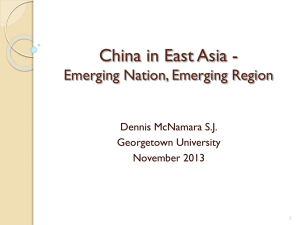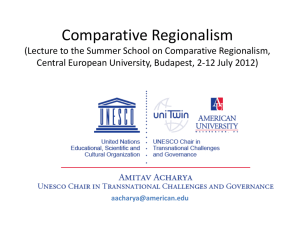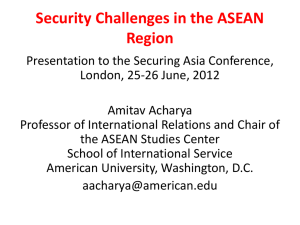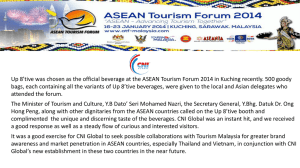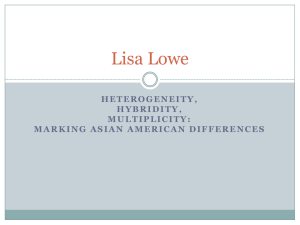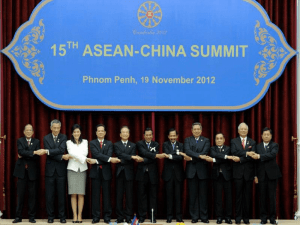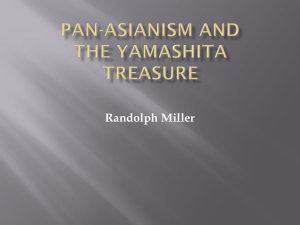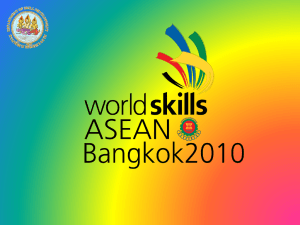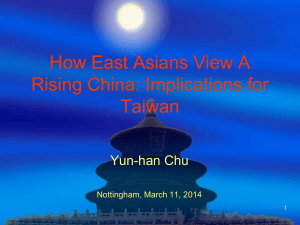asean - Carleton University
advertisement
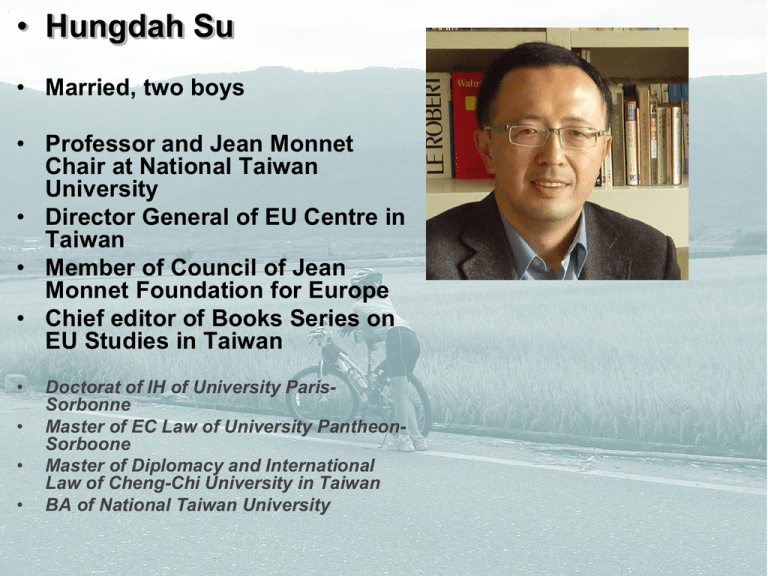
• Hungdah Su • Married, two boys • Professor and Jean Monnet Chair at National Taiwan University • Director General of EU Centre in Taiwan • Member of Council of Jean Monnet Foundation for Europe • Chief editor of Books Series on EU Studies in Taiwan • • • • Doctorat of IH of University ParisSorbonne Master of EC Law of University PantheonSorboone Master of Diplomacy and International Law of Cheng-Chi University in Taiwan BA of National Taiwan University September 18, 2014 EU Centre of Excellence at Carleton University, Canada EU experience and the Competing Asian Regionalism in the aftermath of Financial Crisis Dr. Hungdah Su Professor and Jean Monnet Chair at National Taiwan University Director General of EU Centre in Taiwan (EUTW) Outline 1. Introduction 2. Development of Asian regionalism 3. Competing approaches to Asian regionalism 4. China and Asian regionalism 5. Evaluation of these competing approaches in light of EU experiences 6. Prospect of Asian regionalism Asia as a geographical region Political map of Asia The largest Asia • Area 44.6 million km2 (4 Canada) • Population 3.9 billion (55% of global population) • Polities 47 (including Cypruses, Turkey, Taiwan etc.) Asia defined by UN (without Siberia) Asia defined by the US (ADB) Asia in the context of Asia Pacific Asia defined by EU (ASEM) Some structural but evolving facts 2013 State PRC Population Area (million) (th. Km2) (est. 2014) (2014) 1,356 9,597 127 N.Korea GDP ( trillion $) (2013) 6,594 1/3 378 5.01 39,393 5/5 25 121 0.03 1,127 121/130 S.Korea 49 100 1.20 24,429 7/8 Taiwan 23 36 0.49 20,749 21/20 ASEAN 630 4,481 1.63 2,563 X 1,236 3,287 1.76 1,422 19/9 EU 509 4,325 17.03 33,434 2/1 USA 319 9,827 16.72 52,432 3/2 Japan India 8.94 Income Exports/ (U) Imports (calc.) (rank) (2013) ASEAN State People (million) Area (th. km2) (est. 2014) (2014) Brunei Burma 0.42 56 5.8 677 Cambodia Indonesia Laos 15 254 6.8 181 1,905 237 Malaysia Philippines Singapore 30 108 5.6 330 300 0.7 Vietnam 93 331 Thailand 68 513 Foreign Exchange Reserve (billion $) (est. 2013) State FER PRC 3820 Brazil 378 Japan 1268 S. Korea 342 Eurozone 812 HK 309 Saudi 740 India 277 Russia 517 Singapore 271 Taiwan 415 Regimes and alliances in 2013 International structure in Asia Potentially military conflicts Territorial disputes Conflicts in South China Sea Young nation-buildings based upon old civilizations Young nation-buildings • • • • • 1867 1911 1939 1945 1947 Meiji Reform in Japan Creation of ROC Creation of Modern Thailand Independence of Koreas, Indonesia Independence of India and Pakistan • 1948 Independence of Burma • 1949 Creation of PRC • 1953 Independence of Vietnam, Cambodia and Laos • 1957 Creation of Malaysia • 1967 Indepenedence of Singapore • 1984 Independence of Brunei • 2002 East Timor Debate • Do Asian values exist? - Community is more important than individuals. - Order is more important than liberty. - Consensus replaces confrontation. - Virtue to work hard rather than enjoy life. - ……… Integration in light of EU experience • Integration means a pooling of sovereignty of member states into common institutions. This pooling process could be started with establishment of intergovernmental cooperation, which later developed into supranational integration. Schimmelfennig, Frank and Sedelmeier, Ulrich (2002). Theorizing EU enlargement: research focus, hypotheses, and the state of research. Journal of European Public Policy, 9(4), 500-528. • Integratioin is defined here as ‘vertical institutionalisation’, which includes all the institutionalising developments of intergovernmental cooperation, common policies and Community building. Definition for Asian integration • All developments based upon the integovernmental agreements in the region that aim to constitute any step enumerated by Balassa are defined as parts of Asian integration. Integration in Asia: • Integratoin without strong institutionalization. • Integration without supranational inspiration. • Integration without strong regional identity. Asian integration in comparison • Compared to Europe – No integration/reconciliation among US allies in Asia though US-led alliances guaranteed the regional security. – Regional economy is now driven partly and increasingly by PRC, a non ally of US – All regional projects must include PRC, a non ally of US, a dominant power in Asia. 2. Development of Asian regionalism Until 1945, Asia was dominated by imperialism. Before 1945 • 1924 Su Yat sen proposed Greater Asianism or Pan Asianism in Kobei, Japan, which aimed to persuade Japanese leaders to help liberate Asians from Western imperioalism and build up an Asians’ Asia. Then Sino-Japanese cooperation should constitute the driving force of Asian regionalism. 1940-45 Japan intended to establish the Greater East Asia Co-Prosperity Sphere as part of Japanese militarism in Asia. During the Cold War period • 1966 Asian Development Bank (ADB) • 1967 Pacific Basin Economic Cooperation (PBEC); ASEAN • 1980 Pacific Economic Cooperation Council (PECC) Since 1989 • 1989 Asia Pacific Economic Cooperation (APEC) • 2002 ASEAN plus Process • 2008 Charter of ASEAN; TPP with US • 2010 ASEAN plus PRC; ECFA • 2012 RCEP (Regional Comprehensive Economic Partnership) Asian regionalism • 1960-1980 Japan-initiated integration • Late 1980- mid 1990 US/Australia-led integration • Mid 1990 – early 2000 ASEAN-centred integration • Early 2000 – 2010 China-centred integration • Since 2010 Rising competition between US and China Competing approaches to regionalism in Asia ASEAN APEC SAARC ASEAN Plus (East Asian Summit) xxxxxxxxxxxx SCO Asian IGOs: ASEAN Asian IGOs: APEC SAARC E. Asian Summit (ASEAN plus) Asian IGOs: ASEAN plus • ASEAN 10 • ASEAN 10 plus 1: ASEAN + PRC • ASEAN 10 plus 3: + Japan, S. Korea (East Asian Community) • ASEAN 10 plus 3 plus 3: + India, Australia, New Zealand (East Asian Summit) • ASEAN 10 plus 3 plu 3 plu 1: + USA (APEC +) SCO 3. Competing approaches to Asian regionalism Different and even conflicting approaches US INDIA ASEAN JP PRC American strategy Asian Integrat -ion APEC (TPP) Regionalism of Japan Asian Community JP APEC ASEAN strategy: A tripartite balance N. Asia ASEAN S. Asia Western powers Indian strategy: a balance plus a linkage PRC Arabia INDAN US Asia Regionalism of PRC SCO PRC ASEAN+ 4. China’s strategy towards Asian regionalism Debate • Is regionalism or Asian regionalism in China’s interest? PRC-preferred integration SCO RCEP Qua of China’s diplomacy Bilateral summits With Big Powers G 20 With Int’l Institutions With Neighboring Countries Regionalism With Developing World BRICS Chronology • 1997-1998 Asian financial crisis • 2001 PRC accession to WTO • 2001 Declaration on Conduct of Parties in the South China Sea • 2002 ASEAN plus 1 • 2008 Japan initiated Asian Community ASEAN signed ASEAN Charter • 2010 ASEAN plus 1 and ECFA entered into effect • 2010 ASEAN plus Korea effective ASEAN plus India effective ASEAN-Japan Economic Partnership effective • 2012 RCEP was started K-C-J FTA negotiations were stated. • 2014 C-K FTA will be signed.(?) 5. Evaluation of Asian regionalism in light of EU Experiences Theoretical debate • Liberal Intergovrnmentalism • Neofuctionalism • Institutionalism Liberal intergovernmentalism • Two-level games – National – International • Three-step formulation – Struggle between interest groups – Power struggle between countries – Options for new institutions Neofunctionalism • Transnational cooperation between elite as leadership • Sector integration as the source of spillover Institutionalism • Rational choice approach: supranational institutional leaders • Sociological approach: normative and cognitive forces (values, norms, identities etc.) • Historical approach: path dependency (historical legacies) Evaluation Power structure Historical legacies Elite cooperation Asia Regionalism Normative power Sector integration Regulatory power A very tentative balance sheet Power structure Elite cooperation Sector integration Regulatory power Normative power Cognitive power USA strong strong Weak Weak strong strong Strong Japan Middle Weak None None Weak Weak Weak PRC Middle Middle Strong Weak Weak Middle Middle ASEAN Weak Weak Weak Weak Strong Weak Strong India middle Weak None Weak Weak Weak Weak Historical legacies A very tentative conclusion • The PRC will never be granted leadership as long as it is governed by a communist regime. • The further the PRC-led integration advances, the more the US will strengthen the trans-Pacificism or, to a lesser degree, support the Japanese approach to Asian integration. • The real challenge to the US is the fact that, as the only global superpower, US can never participate in a region-building project. Its policy towards regionalism is always passive and defensive. 6. Prospects 1. Lacking fast track mandate from the Congress and suffering low reputation, Obama government will fail to make TPP adopted by the Congress. 2. On the contrary, negotiations on RCEP could be closed before the end of 2015. • Facing increasing pressure to reform its economy, China will be obliged to participate in the TPP negotiations and open negotiations on FTA with the EU. • These developments may bring US and China to negotiate FTA during the coming years, transforming the dualism of TPP and RCEP into G2 negotiations in the Pacific. • Hungdah Su • Thank you! • Merci!

